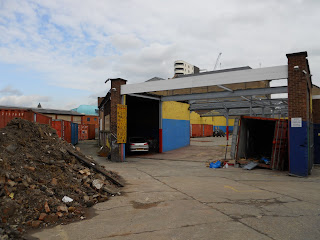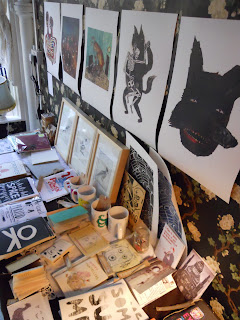
A new gallery and research station opens this month dedicated entirely to Sound Art.
Sound Art is perhaps something that many feel a slight shiver of unease over – there is no set behaviour to this modern medium. When you walk in to a gallery to be faced with a painting there is a certain way of behaving that we know, but when faced with white walls and just noise to contend with, many don’t hang about for long. Perhaps because of this – dare I say it, misunderstanding of Sound Art, there are hardly any institutions in the UK supporting sound artists. And it is this realisation that artist, Helen Frosi and sound designer, Andrew Riley could no longer ignore when they decided to set up the new gallery space, SoundFjord.
Despite there being institutions and galleries that show considerable interest in sound art in their programmes, there is no gallery within London specialising in representing this art form. The gallery space opened officially on Saturday 31st July with Yann Novak’s show, Stillness inaugurating the space soon after, on the 4th August. The size of the gallery is limited to solo shows, so SoundFjord intend to use this space as the hub of the initiative, whilst holding some larger exhibitions and events in other locations.
The name SoundFjord came from a visit to the Fjords Helen and Andrew made in Norway. On the peak of a mountain they took a moment to listen to nature and noticed the huge expanse of sound. This translates to the gallery, which they hope will provide an expanse for artists to project their work. They also intend to hold workshops, lectures, talks and other related events in the space.
SoundFjord recognises the importance of providing networking opportunities. There are many support structures in place for sound artists in countries such as Canada, Belgium, the Netherlands and the US but very little in the UK, and so SoundFjord has come up with Sonic Social - a directory for sound artists which will host events throughout the year. They hope that this will not just be local, but connect people globally. Helen’s monthly SoundFjord newsletter is also a very comprehensive document of things happening at the gallery, opportunities and sound events taking place nationally and abroad – again trying to develop a sound network. And if that’s not enough, they’ve also taken on the challenge of collecting and archiving works of sonic art from across the country to create the Contemporary Sonic Art Archive.
Helen points out that Sound Art has not yet been ‘pigeon- holed’ nor compartmentalised into a definitive “this is Sound Art”, unlike the Visual Arts that has the Sisyphean weight of Art History – and the prescription that goes along with classification – on it’s back. Sound Art is a more recent phenomenon, having only really taken hold in the early 20th Century and not really taking off until the 1960s, and thus is fresh and unbound by categorisation in the main.
Sound Art is intangible – which Western audiences may find disconcerting. Many years of ocularcentricism has taught us how to look, but listening is a different matter. In the main our ears have yet to gain the astute judgement of the eye and listen critically to sound. Helen feels that a great deal of sound art is entwined with technology, which can deter an unspecialised audience. SoundFjord aims to address such misgivings and offers up a venue specifically to highlight the increasing awareness of sound within the Arts. SoundFjord is as a creative hub to learn as well as practice critical listening skills, indeed, so anyone may appreciate sound art.
Although the gallery space wasn’t officially open over summer, SoundFjord held several events. They had an open day at the space for people to come and meet, and held a sound tour in Tottenham, Into the Wild. Fifty artists are already taking part in the making of the future SoundFjord exhibition, Exquisite Corpse. Based on the Surrealist parlour game, Consequences, the artists were each invited to respond to one of the five senses, being divided into groups of ten that responded in a chain. The results of this will be exhibited early next year. It is clear from the events that have already taken place and those involved in the Exquisite Corpse show, to those who have signed up to the SoundFjord newsletter that SoundFjord is a vital resource and centre for inspiration as well as a much needed platform for the community building up around it.
They already have plenty lined up for the future. On Friday 6th August, SoundFjord will curate Immersound, an evening of performances held at The Others, the first in a series of live events that will be held under the title of SoundFjord.Dynamic – the live initiative of the gallery’s Exhibition and Events Programme. On 20th-22nd August, Helen and Andrew take SoundFjord further afield at the Dragonfly Festival in Sweden; armed with 70 artists’ recordings to play in the SoundFjord tent for the premier Sound Art Programme: Alternating Current: Sound Art Now. By the end of September they hope to have a group of sound artists interested in working together to create alternative scores for out of copyright / public domain films, for Sound Cinema. October will see work by Song-Ming Ang, and the Japanese artist Rie Nakajima working With Ken Bodden will exhibit in the gallery from December.
Plenty to listen out for…






















